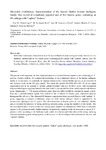Mostrar o rexistro simple do ítem
Molecular evolutionary characterization of the mussel "Mytilus" histone multigene family: first record of a tandemly repeated unit of five histone genes containing an H1 subtype with orphon features
| dc.contributor.author | Eirín-López, J.M. | |
| dc.contributor.author | Ruiz Lorenzo, María Fernanda | |
| dc.contributor.author | González-Tizón, Ana M. | |
| dc.contributor.author | Martínez-Lage, Andrés | |
| dc.contributor.author | Sánchez Rodríguez, Lucas | |
| dc.contributor.author | Méndez, Josefina | |
| dc.date.accessioned | 2019-02-11T19:47:49Z | |
| dc.date.available | 2019-02-11T19:47:49Z | |
| dc.date.issued | 2004-02 | |
| dc.identifier.citation | Molecular evolutionary characterization of the mussel Mytilus histone multigene family: first record of a tandemly repeated unit of five histone genes containing an H1 subtype with “orphon” features. José M. Eirín-López, M. Fernanda Ruiz, Ana M. González-Tizón, Andrés Martínez, Lucas Sánchez, Josefina Méndez, J Mol Evol., (2004), 58(2): 131-144. | es_ES |
| dc.identifier.issn | 0022-2844 | |
| dc.identifier.uri | http://hdl.handle.net/2183/21713 | |
| dc.description.abstract | [Abstract] The present work represents the first characterization of a clustered histone repetitive unit containing an H1 gene in a bivalve mollusk. To complete the knowledge on the evolutionary history of the histone multigene family in invertebrates, we undertake its characterization in five mussel Mytilus species, as an extension of our previous work on the H1 gene family. We report the quintet H4–H2B–H2A–H3–H1 as the major organization unit in the genome of Mytilus galloprovincialis with two 5S rRNA genes with interspersed nontranscribed spacer segments linked to the unit, which is not justified by their cotranscription with histone genes. Surprisingly, 3′ UTR regions of histone genes show two different mRNA termination signals, a stem-loop and a polyadenylation signal, both related to the evolution of histone gene expression patterns throughout the cell cycle. The clustered H1 histones characterized share essential features with “orphon” H1 genes, suggesting a common evolutionary origin for both histone subtypes which is supported by the reconstructed phylogeny for H1 genes. The characterization of histone genes in four additional Mytilus species revealed the presence of strong purifying selection acting among the members of the family. The chromosomal location of most of the core histone genes studied was identified by FISH close to telomeric regions in M. galloprovincialis. Further analysis on nucleotide variation would be necessary to assess if H1 proteins evolve according to the birth-and-death model of evolution and if the effect of the strong purifying selection maintaining protein homogeneity could account for the homologies detected between clustered and “orphon” variants. | es_ES |
| dc.description.sponsorship | Xunta de Galicia; 10PX110304PR | es_ES |
| dc.language.iso | eng | es_ES |
| dc.publisher | Springer Nature | es_ES |
| dc.relation.uri | https://doi.org/10.1007/s00239-003-2531-5 | es_ES |
| dc.rights | This is a post-peer-review, pre-copyedit version of an article published in [Journal of Molecular Evolution]. The final authenticated version is available online at: [https://doi.org/10.1007/s00239-003-2531-5]. | es_ES |
| dc.subject | Mussel Mytilus | es_ES |
| dc.subject | Histone gene quintets | es_ES |
| dc.subject | Orphon genes | es_ES |
| dc.subject | Phylogeny | es_ES |
| dc.subject | Copy number | es_ES |
| dc.subject | FISH (Fluorescence in situ hybridization) | es_ES |
| dc.title | Molecular evolutionary characterization of the mussel "Mytilus" histone multigene family: first record of a tandemly repeated unit of five histone genes containing an H1 subtype with orphon features | es_ES |
| dc.type | info:eu-repo/semantics/article | es_ES |
| dc.rights.access | info:eu-repo/semantics/openAccess | es_ES |
| UDC.journalTitle | Journal of Molecular Evolution | es_ES |
| UDC.volume | 58 | es_ES |
| UDC.issue | 2 | es_ES |
| UDC.startPage | 131 | es_ES |
| UDC.endPage | 144 | es_ES |
Ficheiros no ítem
Este ítem aparece na(s) seguinte(s) colección(s)
-
GI-GIBE - Artigos [74]






